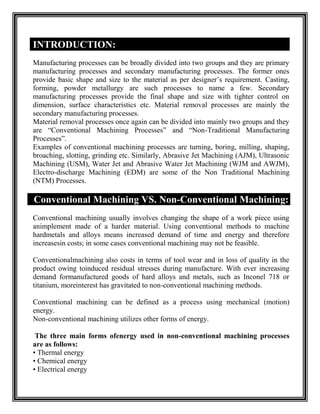
Conventional machining vs. non conventional machining
- 1. INTRODUCTION: Manufacturing processes can be broadly divided into two groups and they are primary manufacturing processes and secondary manufacturing processes. The former ones provide basic shape and size to the material as per designer’s requirement. Casting, forming, powder metallurgy are such processes to name a few. Secondary manufacturing processes provide the final shape and size with tighter control on dimension, surface characteristics etc. Material removal processes are mainly the secondary manufacturing processes. Material removal processes once again can be divided into mainly two groups and they are “Conventional Machining Processes” and “Non-Traditional Manufacturing Processes”. Examples of conventional machining processes are turning, boring, milling, shaping, broaching, slotting, grinding etc. Similarly, Abrasive Jet Machining (AJM), Ultrasonic Machining (USM), Water Jet and Abrasive Water Jet Machining (WJM and AWJM), Electro-discharge Machining (EDM) are some of the Non Traditional Machining (NTM) Processes. Conventional Machining VS. Non-Conventional Machining: Conventional machining usually involves changing the shape of a work piece using animplement made of a harder material. Using conventional methods to machine hardmetals and alloys means increased demand of time and energy and therefore increasesin costs; in some cases conventional machining may not be feasible. Conventionalmachining also costs in terms of tool wear and in loss of quality in the product owing toinduced residual stresses during manufacture. With ever increasing demand formanufactured goods of hard alloys and metals, such as Inconel 718 or titanium, moreinterest has gravitated to non-conventional machining methods. Conventional machining can be defined as a process using mechanical (motion) energy. Non-conventional machining utilizes other forms of energy. The three main forms ofenergy used in non-conventional machining processes are as follows: • Thermal energy • Chemical energy • Electrical energy
- 2. Comparison Conventional Manufacturing Non-Conventional Processes Manufacturing Processes 1. Generally macroscopic chip 1. Material removal may occur with chip formation by shear deformation. formation or even no chip formation may take place. For example in AJM, chips are of microscopic size and in case of Electrochemical machining material removal occurs due to electrochemical dissolution at atomic level 2. There may be a physical tool 2. There may not be a physical tool present. for example a cutting tool present. For example in laser jet in a Lathe Machine, machining, machining is carried out by laser beam. However in Electrochemical Machining there is a physical tool that is very much required for machining. 3. Cutting tool is harder than work 3. There may not be a physical tool piece at room temperature as well present. For example in laser jet as under machining conditions machining, machining is carried out by laser beam. However in Electrochemical Machining there is a physical tool that is very much required for machining. 4. Material removal takes place due 4. Mostly NTM processes do not to application of cutting forces – necessarily use mechanical energy to energy domain can be classified as provide material removal. They use mechanical different energy domains to provide machining. For example, in USM,
- 3. AJM, WJM mechanical energy is used to machine material, whereas in ECM electrochemical dissolution constitutes material removal. 5. Conventional machining involves 5. Whereas unconventional machining the direct contact of tool and work does not require the direct contact of –piece tool and work piece. 6. Lower accuracy and surface 6. Higher accuracy and surface finish. finish. 7. Suitable for every type of material 7. Not Suitable for every type of material economically economically 8. Tool life is lessdue to high surface 8. Tool life is more contact and wear. 9. Higher waste of material due to 9. Lower waste of material due to low or high wear. no wear. 10. Noisy operation mostly cause 10. Quieter operation mostly no sound sound pollutions pollutions are produced. 11. Lower capital cost 11. Higher capital cost 12. Easy set-up of equipment. 12. Complex set-upequipment. 13. Skilled or un-skilled operator 13. Skilled operator required. may required 14. Generally they are manual to 14. Generally they are fully automated operate. process. 15. They cannot be used to produce 15. Can be used to produce prototype prototype parts very efficiently parts very efficientlyAnd and economically. economically.
